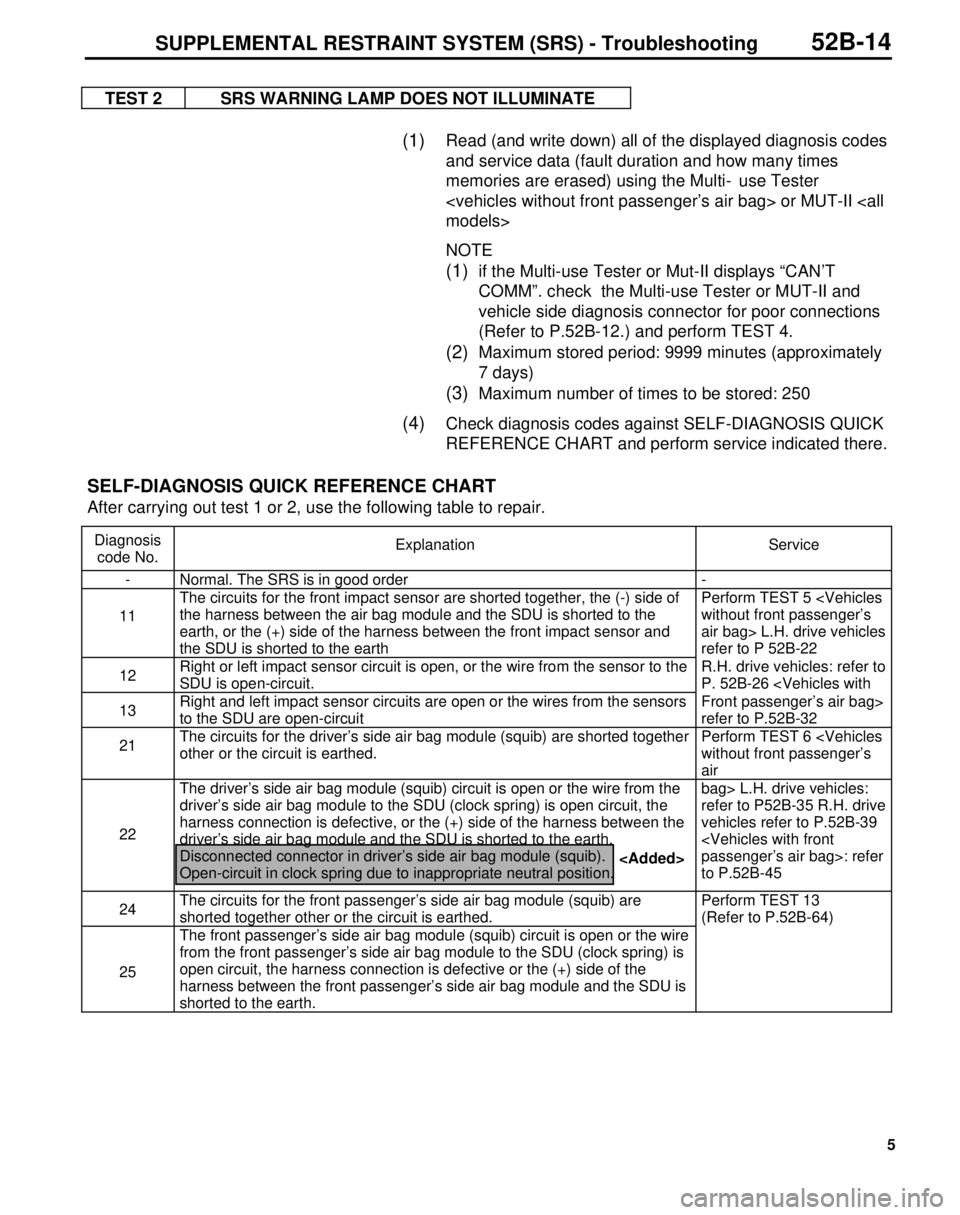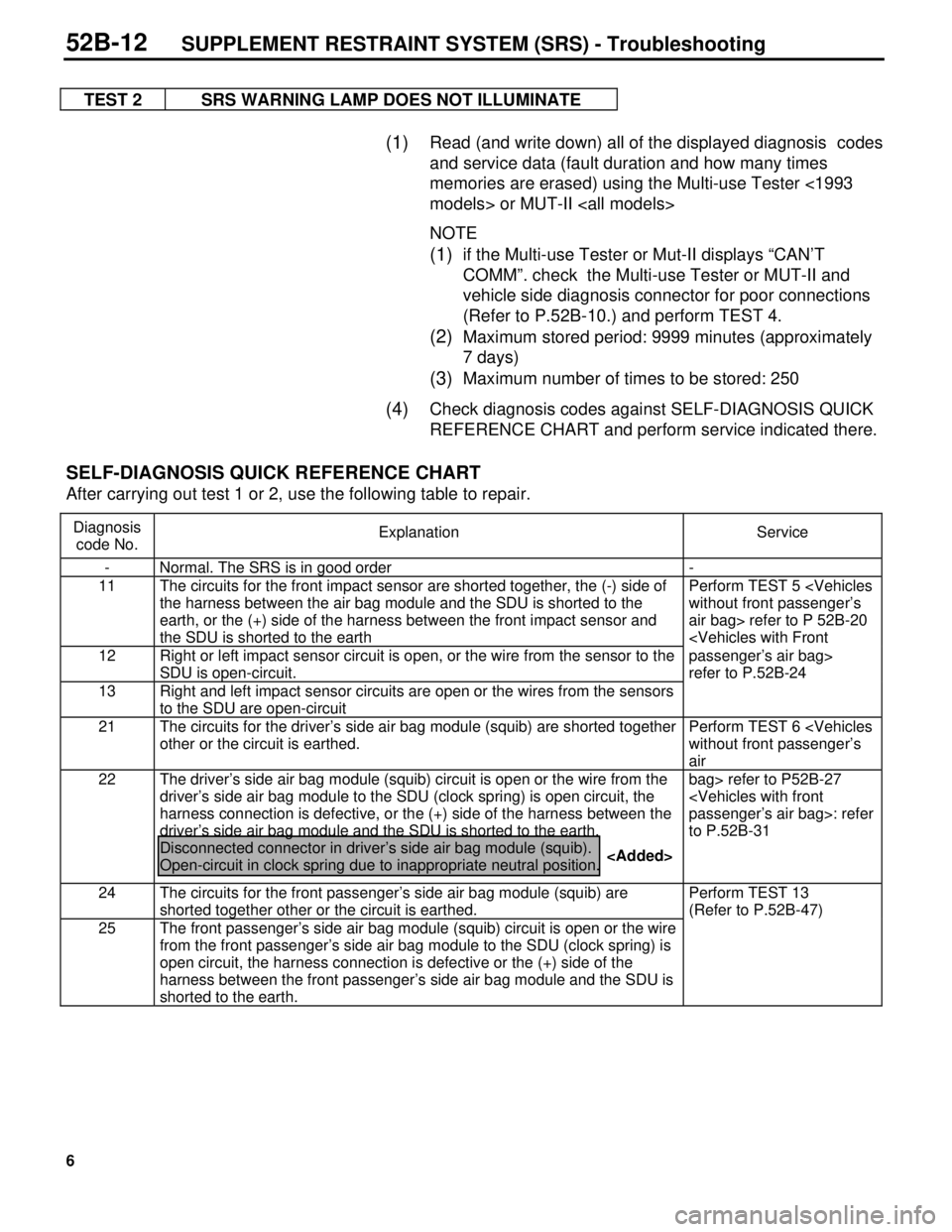1997 MITSUBISHI TRITON warning
[x] Cancel search: warningPage 990 of 1310

10
2.
Exit conditions from the adjustment mode
The ETACS-ECU cancels the adjustment mode when any of the following conditions is satisfied:
•
Diagnosis control: OFF (Disconnect the MUT-II>)
•
Key reminder switch: ON (Pull out the ignition key.)
•
Ignition switch: Other than LOCK (OFF)
•
Door switch: ON (Open the door)
•
After the ETACS_ECU has entered the adjustment mode, no adjustment is made within 3 minutes (If
any adjustment is made within 3 minutes, the ETACS-ECU monitors an adjustment operation for
other 3 minutes.
•
Other warning buzzer(s) sounds
3.
Adjustment of functions
Function Adjustment procedure
Keyless entry answerback function When the transmitter lock switch is turned on twice continuously
within 2 seconds, the lock answerback function toggles on and off.
•
If the function toggles on, the buzzer sounds once (default con-
dition).
•
If the function toggles off, the buzzer sounds twice,
When the transmitter unlock switch is turned on twice continuously
within 2 seconds, the unlock answerback function toggles on and
off.
•
If the function toggles on, the buzzer sounds once (default con-
dition).
•
If the function toggles off, the buzzer sounds twice,
Initialisation of all the ETACS func-
tions (From deactivation to activa-
tion)When the tailgate switch remains on for more than 20 seconds, th
buzzer sounds twice and he answer-back function of the keyless
entry system is initialised.
The buzzer will sound in 10 seconds (indicating that the ETACS-
ECU enters the adjustment mode), but the washer switch must re-
mains off for 20 seconds in order to initialise all the functions.
If the tailgate switch remains on for more than 20 seconds without
entering the adjustment mode, the system enters the adjustment
mode in 10 seconds, but does not initialise all of the functions.
INSPECTION CHART FOR TROUBLE SYMPTOMS
Trouble symptom Inspection procedure No. Reference page
None of the doors can be locked or unlocked using th
transmitter.142-3
All of the doors can be locked and unlocked using th
transmitter, but the room lamp or turn-signal lamp does
not flash or illuminate. (However, the room lamp oper-
ates normally when the doors are opened and closed.)242-4
Encrypted codes cannot be registered. 3 42-5
42-2BODY – Keyless entry system
Page 1002 of 1310

3
TROUBLESHOOTING35201110129
STANDARD FOW OF DIAGNOSTIC TROUBLESHOOTING
Refer to GROUP 00 – How to Use Troubleshooting/Inspection Service Points.
NOTES WITH REGARD TO DIAGNOSIS
The phenomena listed in the following table are not abnormal.
Phenomenon Explanation of phenomenon
System check sound When starting the engine, a thudding sound can sometimes
be heard coming from inside the engine compartment, but
this is because the system operation check is being
performed, and is not an abnormality.
ABS operation sound Sound of the motor inside the ABS hydraulic unit operation.
(whine)
Sound is the generated along with vibration of the brak
pedal. (Scraping).
When ABS operates, sound is generated from the vehicle
chassis due to repeated brake application and release.
(Thump: suspension; squeak: tyres)
ABS operation (Long braking distance) For road surfaces such as snow-covered roads and gravel
roads, the braking distance for vehicles with ABS can
sometimes be longer than that for other vehicles.
Accordingly, advise the customer to drive safely on suc
roads by lowering the vehicle speed and not being too
overconfident.
Diagnosis detection condition can vary depending on the diagnosis code.
Make sure that checking requirements listed in the “Comment” are satisfied when checking the trouble
symptom again.
DIAGNOSIS FUNCTION 35201120106
DIAGNOSIS CODES CHECK
Read a diagnosis code by the MUT-II or ABS
warning lamp. (Refer to GROUP 00 – How to Use
Troubleshooting/Inspection Service Points.)
ERASING DIAGNOSIS CODES
Refer to GROUP 00 – How to Use
Troubleshooting/Inspection Service Points.
See next page.
ABS <2WD> - Troubleshooting35B-6
Page 1004 of 1310

5
4.
Remedy the malfunctions indicated by th
diagnosis codes, disconnect the diagnosis code
check harness, and then install the valve relay.
Then turn the ignition switch to ON again t
check the ABS warning lamp. (Refer to P.35-36-
16.) If the lamp indicates a malfunction, th
valve relay system may be detective. (Refer to
P.35-36-14.)
ERASING DIAGNOSIS CODES
Connect the MUT-II to the diagnosis connector (16-
pin), and then erase the diagnosis codes.
Without the MUT-II
Remove the battery cable from the battery (-)
terminal for 10 seconds or more, and the
reconnect the cable.
SERVICEBRAKES – ABS Troubleshooting
Page 1006 of 1310

7
4.
Remedy the malfunctions indicated by th
diagnosis codes, disconnect the diagnosis code
check harness, and then reconnect the valve
relay harness. Then turn the ignition switch to ON
again to check the ABS warning lamp. (Refer to
P.35B-19.) If the lamp indicates a malfunction,
the valve relay system may be defective. (Refer
to P.35B-17)
ERASING DIAGNOSTIC CODES
Connect the MUT-II to the diagnosis connector (16-
pin), then erase the diagnostic codes.
Without the MUT-II
Removing the battery cable from the battery (-)
terminal for 10 seconds or more, then reconnect the
cable.
ABS <2WD> - Troubleshooting35B-7
Page 1008 of 1310

9
TROUBLESHOOTING35201110501
STANDARD FLOW OF DIAGNOSTIC TROUBLESHOOTING
Refer to GROUP 00 – How to Use Troubleshooting/Inspection Service Points
NOTES WITH REGARD TO DIAGNOSIS
The Phenomena listed in the following table are not abnormal.
Phenomenon Explanation of phenomenon
System check sound When starting the engine, a thudding sound can sometimes be hear
coming from inside the engine compartment, but this is because the
system operation check is being performed, and is not an abnormality.
ABS operation sound 1.
Sound of the motor inside the ABS hydraulic unit operation (whine).
2.
Sound is generated along with vibration of the brake pedal (scraping)
3.
When ABS operates, sound is generated from the vehicle chassis
due to repeated brake application and release.
(Thump: suspension: squeak: tyres)
ABS operation (Long braking
distance)For road surfaces suck as snow-covered roads a gravel roads, the
braking distance for vehicles with ABS can sometimes be longer than
that for other vehicles. Accordingly, advise the customer to drive safely
on suck roads by lowering the vehicle speed and not being to
overconfident.
Diagnosis detection condition can vary depending on the diagnosis code.
Make sure that checking requirements listed in the “Comment” are satisfied when checking the trouble
symptom again.
DIAGNOSIS FUNCTION35201120351
DIAGNOSIS CODES CHECK
Read a diagnosis code by the MUT-II or ABS warning
lamp. (Refer to GROUP 00 - How to Use Trouble-
shooting/Inspection Service Points.)
ERASING DIAGNOSIS CODES
With the MUT-II
Refer to GROUP 00 – How to Use
Troubleshooting/Inspection Service Points
When diagnostic trouble codes (Nos. 21 to 24) (for vehicle wheel speed sensor system failures) occur,
normal MUT-II operation may not erase those codes. In that case, erase the diagnostic trouble codes
using the following procedures.
1.
Perform erasing of the diagnostic trouble codes by special operation of the brake pedal. (See erasing
procedure for the diagnostic trouble codes without use of the MUT-II.)
2.
Turn the ignition switch OFF.
3.
Perform erasing of the diagnostic trouble codes by use of the MUT-II.
ABS <4WD> - Troubleshooting35B-4
><
Page 1010 of 1310

11
TROUBLESHOOTING35201110143
STANDARD FLOW OF DIAGNOSTIC TROUBLESHOOTING
Refer to GROUP 00 – How to Use Troubleshooting/Inspection Service Points
NOTES WITH REGARD TO DIAGNOSIS
The Phenomena listed in the following table are not abnormal.
Phenomenon Explanation of phenomenon
System check sound When starting the engine, a thudding sound can sometimes be hear
coming from inside the engine compartment, but this is because the
system operation check is being performed, and is not an abnormality.
ABS operation sound 1.
Sound of the motor inside the ABS hydraulic unit operation (whine).
2.
Sound is generated along with vibration of the brake pedal
(scraping)
3.
When ABS operates, sound is generated from the vehicle chassis
due to repeated brake application and release.
(Thump: suspension: squeak: tyres)
ABS operation (Long braking
distance)For road surfaces suck as snow-covered roads an gravel roads, the
braking distance for vehicles with ABS can sometimes be longer than
that for other vehicles. Accordingly, advise the customer to drive safely
on suck roads by lowering the vehicle speed and not being to
overconfident.
Shock during system operation
checkShock may be felt when the brake pedal is depressed slightly at a low
driving speed. This occurs due to ABS operation check (initial check at
a vehicle speed of 8 km/h), and does not indicate any malfunction.
Diagnosis detection condition can vary depending on the diagnosis code.
Make sure that checking requirements listed in the “Comment” are satisfied when checking the trouble
symptom again.
DIAGNOSIS FUNCTION35201120108
DIAGNOSIS CODES CHECK
Read a diagnosis code by the MUT-II or ABS warning
lamp. (Refer to GROUP 00- How to Use
Troubleshooting/Inspection Service Points.)
ERASING DIAGNOSIS CODES
Troubleshooting/Inspection Service Points.
ABS <2WD> - Troubleshooting35B-5
Page 1026 of 1310

5
TEST 2 SRS WARNING LAMP DOES NOT ILLUMINATE
(1) Read (and write down) all of the displayed diagnosis codes
and service data (fault duration and how many times
memories are erased) using the Multi- use Tester
NOTE
(1) if the Multi-use Tester or Mut-II displays “CAN’T
COMM”. check the Multi-use Tester or MUT-II and
vehicle side diagnosis connector for poor connections
(Refer to P.52B-12.) and perform TEST 4.
(2) Maximum stored period: 9999 minutes (approximately
7 days)
(3) Maximum number of times to be stored: 250
(4) Check diagnosis codes against SELF-DIAGNOSIS QUICK
REFERENCE CHART and perform service indicated there.
SELF-DIAGNOSIS QUICK REFERENCE CHART
After carrying out test 1 or 2, use the following table to repair.
Diagnosis
code No.Explanation Service
- Normal. The SRS is in good order -
11The circuits for the front impact sensor are shorted together, the (-) side of
the harness between the air bag module and the SDU is shorted to the
earth, or the (+) side of the harness between the front impact sensor and
the SDU is shorted to the earthPerform TEST 5
air bag> L.H. drive vehicles
refer to P 52B-22
12Right or left impact sensor circuit is open, or the wire from the sensor to the
SDU is open-circuit.R.H. drive vehicles: refer to
P. 52B-26
to the SDU are open-circuitFront passenger’s air bag>
refer to P.52B-32
21The circuits for the driver’s side air bag module (squib) are shorted together
other or the circuit is earthed.Perform TEST 6
air
22The driver’s side air bag module (squib) circuit is open or the wire from the
driver’s side air bag module to the SDU (clock spring) is open circuit, the
harness connection is defective, or the (+) side of the harness between the
driver’s side air bag module and the SDU is shorted to the earth.
Disconnected connector in driver’s side air bag module (squib).
Open-circuit in clock spring due to inappropriate neutral position.bag> L.H. drive vehicles:
refer to P52B-35 R.H. drive
vehicles refer to P.52B-39
to P.52B-45
24The circuits for the front passenger’s side air bag module (squib) are
shorted together other or the circuit is earthed.Perform TEST 13
(Refer to P.52B-64)
25The front passenger’s side air bag module (squib) circuit is open or the wire
from the front passenger’s side air bag module to the SDU (clock spring) is
open circuit, the harness connection is defective or the (+) side of the
harness between the front passenger’s side air bag module and the SDU is
shorted to the earth.
SUPPLEMENTAL RESTRAINT SYSTEM (SRS) - Troubleshooting52B-14
Page 1027 of 1310

6
TEST 2 SRS WARNING LAMP DOES NOT ILLUMINATE
(1) Read (and write down) all of the displayed diagnosis codes
and service data (fault duration and how many times
memories are erased) using the Multi-use Tester <1993
models> or MUT-II
NOTE
(1) if the Multi-use Tester or Mut-II displays “CAN’T
COMM”. check the Multi-use Tester or MUT-II and
vehicle side diagnosis connector for poor connections
(Refer to P.52B-10.) and perform TEST 4.
(2) Maximum stored period: 9999 minutes (approximately
7 days)
(3) Maximum number of times to be stored: 250
(4) Check diagnosis codes against SELF-DIAGNOSIS QUICK
REFERENCE CHART and perform service indicated there.
SELF-DIAGNOSIS QUICK REFERENCE CHART
After carrying out test 1 or 2, use the following table to repair.
Diagnosis
code No.Explanation Service
- Normal. The SRS is in good order -
11 The circuits for the front impact sensor are shorted together, the (-) side of
the harness between the air bag module and the SDU is shorted to the
earth, or the (+) side of the harness between the front impact sensor and
the SDU is shorted to the earthPerform TEST 5
air bag> refer to P 52B-20
SDU is open-circuit.passenger’s air bag>
refer to P.52B-24
13 Right and left impact sensor circuits are open or the wires from the sensors
to the SDU are open-circuit
21 The circuits for the driver’s side air bag module (squib) are shorted together
other or the circuit is earthed.Perform TEST 6
air
22 The driver’s side air bag module (squib) circuit is open or the wire from the
driver’s side air bag module to the SDU (clock spring) is open circuit, the
harness connection is defective, or the (+) side of the harness between the
driver’s side air bag module and the SDU is shorted to the earth.
Disconnected connector in driver’s side air bag module (squib).
Open-circuit in clock spring due to inappropriate neutral position.bag> refer to P52B-27
to P.52B-31
24 The circuits for the front passenger’s side air bag module (squib) are
shorted together other or the circuit is earthed.Perform TEST 13
(Refer to P.52B-47)
25 The front passenger’s side air bag module (squib) circuit is open or the wire
from the front passenger’s side air bag module to the SDU (clock spring) is
open circuit, the harness connection is defective or the (+) side of the
harness between the front passenger’s side air bag module and the SDU is
shorted to the earth.
52B-12SUPPLEMENT RESTRAINT SYSTEM (SRS) - Troubleshooting